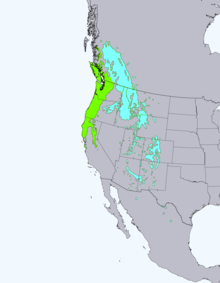Common Douglas-fir
| Douglas-fir | |
|---|---|
 |
|
| Coast Douglas firs in Marysville, Washington | |
| Scientific classification | |
| Kingdom: | Plantae |
| Division: | Pinophyta |
| Class: | Pinopsida |
| Order: | Pinales |
| Family: | Pinaceae |
| Genus: | Pseudotsuga |
| Species: | P. menziesii |
| Binomial name | |
|
Pseudotsuga menziesii (Mirb.) Franco |
|
 |
|
|
Green: Coast Douglas-fir (Pseudotsuga menziesii var. menziesii)
Blue: Rocky Mountain Douglas-fir (Pseudotsuga menziesii var. glauca)
|
|
Pseudotsuga menziesii, commonly known as Douglas fir, Douglas-fir and Oregon pine, is an evergreen conifer species native to western North America. One variety, the coast Douglas fir, grows along the Pacific Ocean from central British Columbia south to central California. A second variety, the Rocky Mountain Douglas fir, grows in the Rocky Mountains from British Columbia south to Mexico. The tree is dominant in western Washington and Oregon. It is extensively used for timber, worldwide.
The common name honors David Douglas, a Scottish botanist and collector who first reported the extraordinary nature and potential of the species. The common name is misleading since it is not a true fir, i.e., not a member of the genus Abies. For this reason the name is often written as Douglas-fir (a name also used for the genus Pseudotsuga as a whole).
The specific epithet, menziesii, is after Archibald Menzies, a Scottish physician and rival naturalist to David Douglas. Menzies first documented the tree on Vancouver Island in 1791. Colloquially, the species is also known simply as Doug-fir or as Douglas pine (although the latter common name may also refer to Pinus douglasiana).
...
Wikipedia

